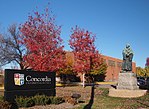Hamline Avenue station

Hamline Avenue station is a light rail station on the METRO Green Line in Saint Paul, Minnesota. It is located along University Avenue on both sides of the intersection with Hamline Avenue. The station has split side platforms, with the westbound platform on the north side of the tracks west of Hamline and the eastbound platform on the south side of the tracks east of the intersection.Along with Victoria Street Station and Western Avenue Station, this station was originally planned to be an infill station that would be built after the main line had been constructed when there was sufficient demand. However, significant political pressure and changes in the Federal Transit Administration's rules led to an early 2010 announcement that it would be built with the rest of the line.Construction in this area began in 2011. The station opened along with the rest of the line in 2014.
Excerpt from the Wikipedia article Hamline Avenue station (License: CC BY-SA 3.0, Authors, Images).Hamline Avenue station
North Hamline Avenue, Saint Paul Hamline - Midway
Geographical coordinates (GPS) Address External links Nearby Places Show on map
Geographical coordinates (GPS)
| Latitude | Longitude |
|---|---|
| N 44.955711111111 ° | E -93.156811111111 ° |
Address
Hamline Avenue
North Hamline Avenue
55104 Saint Paul, Hamline - Midway
Minnesota, United States
Open on Google Maps







